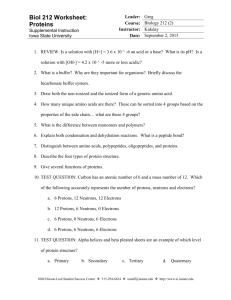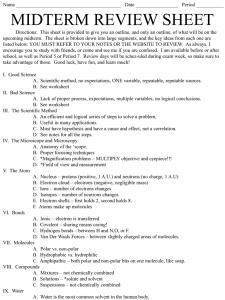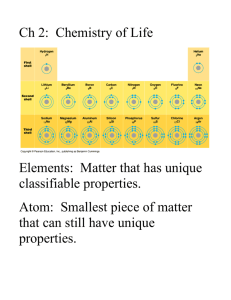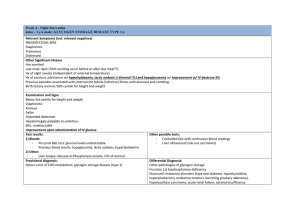___ 4
advertisement
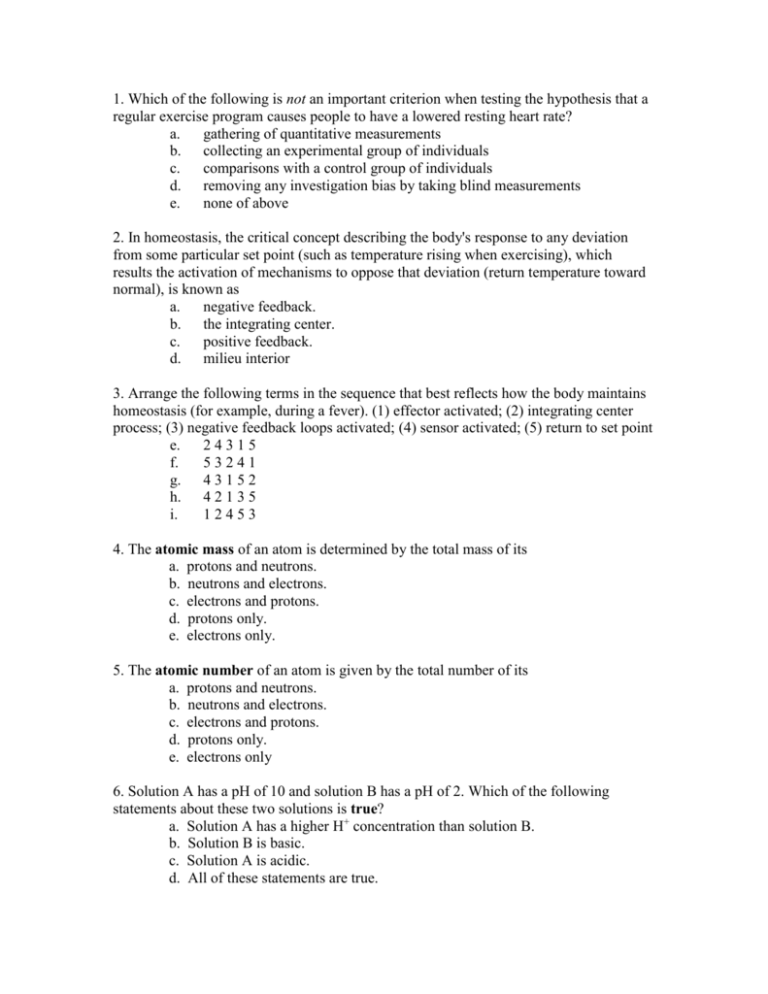
1. Which of the following is not an important criterion when testing the hypothesis that a regular exercise program causes people to have a lowered resting heart rate? a. gathering of quantitative measurements b. collecting an experimental group of individuals c. comparisons with a control group of individuals d. removing any investigation bias by taking blind measurements e. none of above 2. In homeostasis, the critical concept describing the body's response to any deviation from some particular set point (such as temperature rising when exercising), which results the activation of mechanisms to oppose that deviation (return temperature toward normal), is known as a. negative feedback. b. the integrating center. c. positive feedback. d. milieu interior 3. Arrange the following terms in the sequence that best reflects how the body maintains homeostasis (for example, during a fever). (1) effector activated; (2) integrating center process; (3) negative feedback loops activated; (4) sensor activated; (5) return to set point e. 24315 f. 53241 g. 4 3 1 5 2 h. 4 2 1 3 5 i. 12453 4. The atomic mass of an atom is determined by the total mass of its a. protons and neutrons. b. neutrons and electrons. c. electrons and protons. d. protons only. e. electrons only. 5. The atomic number of an atom is given by the total number of its a. protons and neutrons. b. neutrons and electrons. c. electrons and protons. d. protons only. e. electrons only 6. Solution A has a pH of 10 and solution B has a pH of 2. Which of the following statements about these two solutions is true? a. Solution A has a higher H+ concentration than solution B. b. Solution B is basic. c. Solution A is acidic. d. All of these statements are true. e. None of these statements is true. 7. The general formula of a carbohydrate molecule is a. (H2O)C. b. H2OCC. c. CH2O. d. H2O. 8. Extra sugar molecules in the body are condensed and stored in the liver and muscles as a polymer known as a. glycogen. b. glucose. c. galactose. d. glucagons. e. starch. 9. The approximate number of amino acids that form proteins is a. eight. b. twelve. c. twenty. d. twenty-three. e. forty-six. 10. Which of the following is not a function of proteins? a. add structure or strength to connective tissues b. prevent water loss through the skin c. catalyze reactions as enzymes d. serve as antibodies, preventing infection e. serve as cell membrane receptors and carrier molecules f. All of these are functions of proteins 11. In which of the following relationships is the law of complementary base pairing not enforced? a. guanine pairs with cytosine b. cytosine pairs with thymine c. thymine pairs with adenine 12. Organelles, known as “protein factories” because proteins are assembled here as directed by the genetic information delivered by messenger RNA, refer to the a. mitochondria. b. lysosome. c. Golgi complex. d. ribosomes. e. endoplasmic reticulum. 13. Which of the following statements best describes the term, genome? a. the zygote formed by the union of the males sperm and female ovum b. the smallest possible gene in the chromosome c. another name for the nucleus (home for the DNA) d. all of the genes in a particular individual or all of the genes in a particular species e. all of the protein (polypeptide) molecules coded for by the genes 14. The nitrogenous base in DNA that is not found in RNA is a. adenine. b. guanine. c. thymine. d. cytosine. e. uracil. 15. Which of the following is not a type of ribonucleic acid (RNA)? a. messenger b. mitochondrial c. transfer d. ribosomal 16. Translation is best defined as the synthesis of a. mRNA, tRNA, and rRNA from DNA in the nucleus. b. pre-mRNA only from DNA in the nucleus. c. specific proteins from the mRNA base sequence code. d. new, complementary strands of DNA in the nucleus. 17. Enzymes make reactions go faster by a. increasing the energy level of the reactants. b. lowering the activation energy. c. raising the temperature of the reaction. d. reducing the repulsion between ions within the reactants. 18. In enzyme-catalyzed reactions, the reactant molecules are better known as a. active sites. b. substrates. c. enzyme-substrate complexes. d. products. 19. Synthesis of larger, energy storage molecules from smaller molecules, best describes a. anabolism. b. metabolism. c. catabolism. 20. Which of the following statements about glycolysis is false? a. It results in the ultimate formation of two molecules of pyruvic acid. b. c. d. e. It results in the net gain of two ATP molecules. It can occur without oxygen present. It is exergonic. All of these statements about glycolysis are true. 21. The organ most responsible for extracting and converting lactic acid to pyruvic acid, and which ultimately reforms and releases free glucose into the bloodstream, is the a. liver. b. brain. c. cardiac muscle. d. skeletal muscle. e. kidney. 22. The process in question above, which describes the conversion of noncarbohydrate molecules into glucose, is known as a. glycogenolysis. b. glycogenesis. c. gluconeogenesis. d. glycolysis. 23. The Cori cycle is the process by which a. liver glycogen is exchanged for muscle glycogen. b. blood glucose is stored as liver glycogen. c. muscle lactic acid is stored as muscle glycogen. d. blood lactic acid is converted to glucose by the liver. e. liver glucose is converted to lactic acid and released into the bloodstream. 24. The breakdown of stored glycogen into individual molecules of glucose 6-phosphate occurs during the process known as a. glycolysis. b. gluconeogenesis. c. glycogenolysis. d. glycogenesis. 25. Acetyl CoA is an important metabolic intersection that can lead to the formation of all of the following substances, except a. CO2 via Krebs cycle. b. cholesterol and steroids. c. ketone bodies. d. fatty acids and triglycerides. e. All of these substances are formed from acetyl CoA. True or False 26. _____ In biomedical research, subjects that are part of an experimental group could also serve as their own control group. 27. _____ Atoms may exist as isotopes, which have the same atomic mass but a different atomic numbers 28. _____ An atom that gains more electrons than it has protons becomes a negatively charged ion called a cation 29. _____ A base is usually a molecule that can combine with H+, remove that H+ from solution, and thus lower the overall pH value of the solution. 30. _____ Basic (alkaline) solutions have a pH of less than 7, whereas acidic solutions have a pH between 7 and 14. 31. _____ Excessive vomiting causes the loss of gastric (stomach) acid resulting in a rise in the blood concentration of free H+ that could be measured as a fall in the blood pH. 32. _____ Stereoisomers may have exactly the same arrangement of atoms in exactly the same sequence yet may differ in their 3-dimensional orientations in space. 33. _____ Starch is a polysaccharide of glucose, stored in plants 34. _____ Genetic expression occurs in two stages: first genetic translation and then genetic transcription 35. _____ The sequence of three bases (a base triplet) in tRNA is called a codon, while the complementary triplet in mRNA is called an anticodon. 36. _____ Most proteins are enzymes. 37. _____ During metabolism, the product formed by one enzyme can become the substrate for the next enzyme in the pathway. 38. _____ The first law of thermodynamics states that energy can be neither created nor destroyed 39. _____ The breakdown of ATP ADP + Pi is an exergonic reaction. 40. _____ Anaerobic respiration yields a net gain of two ATP molecules. 41. _____ Glycolysis occurs in the mitochondrion




